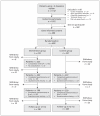A proactive approach to migraine in primary care: a pragmatic randomized controlled trial
- PMID: 22231680
- PMCID: PMC3291695
- DOI: 10.1503/cmaj.110908
A proactive approach to migraine in primary care: a pragmatic randomized controlled trial
Abstract
Background: Migraine is a common, disabling headache disorder that leads to lost quality of life and productivity. We investigated whether a proactive approach to patients with migraine, including an educational intervention for general practitioners, led to a decrease in headache and associated costs.
Methods: We conducted a pragmatic randomized controlled trial. Participants were randomized to one of two groups: practices receiving the intervention and control practices. Participants were prescribed two or more doses of triptan per month. General practitioners in the intervention group received training on treating migraine and invited participating patients for a consultation and evaluation of the therapy they were receiving. Physicians in the control group continued with usual care. Our primary outcome was patients' scores on the Headache Impact Test (HIT-6) at six months. We considered a reduction in score of 2.3 points to be clinically relevant. We used the Kessler Psychological Distress Scale (K10) questionnaire to determine if such distress was a possible effect modifier. We also examined the interventions' cost-effectiveness.
Results: We enrolled 490 patients in the trial (233 to the intervention group and 257 to the control group). Of the 233 patients in the intervention group, 192 (82.4%) attended the consultation to evaluate the treatment of their migraines. Of these patients, 43 (22.3%) started prophylaxis. The difference in change in score on the HIT-6 between the intervention and control groups was 0.81 (p = 0.07, calculated from modelling using generalized estimating equations). For patients with low levels of psychological distress (baseline score on the K10 ≤ 20) this change was -1.51 (p = 0.008), compared with a change of 0.16 (p = 0.494) for patients with greater psychological distress. For patients who were not using prophylaxis at baseline and had two or more migraines per month, the mean HIT-6 score improved by 1.37 points compared with controls (p = 0.04). We did not find the intervention to be cost-effective.
Interpretation: An educational intervention for general practitioners and a proactive approach to patients with migraine did not result in a clinically relevant improvement of symptoms. Psychological distress was an important confounder of success. (Current Controlled Trials registration no. ISRCTN72421511.).
Figures
Similar articles
-
Botulinum toxin type A and acute drug costs in migraine with triptan overuse.Can J Neurol Sci. 2010 Sep;37(5):588-94. doi: 10.1017/s031716710001074x. Can J Neurol Sci. 2010. PMID: 21059503
-
Acupuncture of chronic headache disorders in primary care: randomised controlled trial and economic analysis.Health Technol Assess. 2004 Nov;8(48):iii, 1-35. doi: 10.3310/hta8480. Health Technol Assess. 2004. PMID: 15527670 Review.
-
Botulinum toxin type A as migraine preventive treatment in patients previously failing oral prophylactic treatment due to compliance issues.Headache. 2008 Jun;48(6):900-13. doi: 10.1111/j.1526-4610.2007.00953.x. Epub 2007 Nov 28. Headache. 2008. PMID: 18047501 Clinical Trial.
-
Migraine Nurses in Primary Care: Costs and Benefits.Headache. 2017 Sep;57(8):1252-1260. doi: 10.1111/head.13098. Epub 2017 May 19. Headache. 2017. PMID: 28524254
-
The effect of migraine prophylaxis on migraine-related resource use and productivity.CNS Drugs. 2009 Sep;23(9):727-38. doi: 10.2165/11314380-000000000-00000. CNS Drugs. 2009. PMID: 19689164 Review.
Cited by
-
Impact of an Electronic Health Record-Based Interruptive Alert Among Patients With Headaches Seen in Primary Care: Cluster Randomized Controlled Trial.JMIR Med Inform. 2024 Aug 29;12:e58456. doi: 10.2196/58456. JMIR Med Inform. 2024. PMID: 39207446 Free PMC article.
-
Structured education can improve primary-care management of headache: the first empirical evidence, from a controlled interventional study.J Headache Pain. 2016;17:24. doi: 10.1186/s10194-016-0613-1. Epub 2016 Mar 11. J Headache Pain. 2016. PMID: 26969188 Free PMC article. Clinical Trial.
-
Knowledge, Attitudes, and Management of General Practitioners of the Hospital Districts of Ouagadougou about Migraine (Burkina Faso).Pain Res Manag. 2021 Nov 18;2021:9327363. doi: 10.1155/2021/9327363. eCollection 2021. Pain Res Manag. 2021. PMID: 34840637 Free PMC article.
-
Continuing education meetings and workshops: effects on professional practice and healthcare outcomes.Cochrane Database Syst Rev. 2021 Sep 15;9(9):CD003030. doi: 10.1002/14651858.CD003030.pub3. Cochrane Database Syst Rev. 2021. PMID: 34523128 Free PMC article.
-
Effect of Educating the Primary Care Physician About Headache to Help Reduce "Trivial" Referrals and Improve the Number and Quality of "Substantial" Referrals that Truly Need Subspecialty Headache Medicine Care.Curr Treat Options Neurol. 2017 Jul;19(7):25. doi: 10.1007/s11940-017-0462-5. Curr Treat Options Neurol. 2017. PMID: 28536899 Review.
References
-
- Brown JS, Neumann PJ, Papadopoulos G, et al. Migraine frequency and health utilities: findings from a multisite survey. Value Health 2008;11:315–21 - PubMed
-
- Lipton RB, Bigal ME. The epidemiology of migraine. Am J Med 2005;118(Suppl 1):3S–10S - PubMed
-
- Lipton RB, Bigal ME, Diamond M, et al. Migraine prevalence, disease burden, and the need for preventive therapy. Neurology 2007;68:343–9 - PubMed
-
- Terwindt GM, Ferrari MD, Tijhuis M, et al. The impact of migraine on quality of life in the general population: the GEM study. Neurology 2000;55:624–9 - PubMed
-
- Stewart WF, Wood GC, Razzaghi H, et al. Work impact of migraine headaches. J Occup Environ Med 2008;50:736–45 - PubMed
Publication types
MeSH terms
Substances
Associated data
LinkOut - more resources
Full Text Sources
Medical
Research Materials

